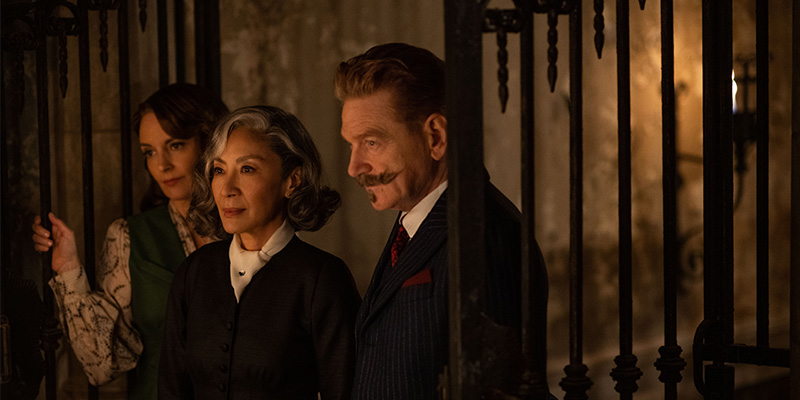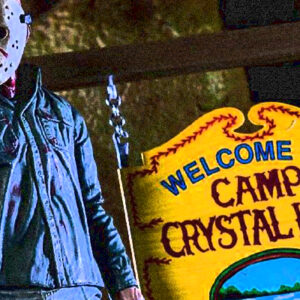I was impressed by A Haunting in Venice as much as I was relieved by it.
I had always found it both delightful and intriguing that, of all the possible franchises to take on, Kenneth Branagh chose Hercule Poirot, a funny, punctilious little Belgian detective. Yes, Poirot is one of the best—and best-known—detectives in literature and Branagh clearly likes adapting characters with that kind of stature. But still, Poirot is a quirky, portly dilettante. Why not Sherlock Holmes? Why not Father Brown? It’s a brain-tickler, for sure.
My appreciation for Branagh as a creative presence comes in waves of different sizes—I admire his unrelenting enthusiasm for drama, while I have always been a little wary of his near-constant self-centering within his art, including his seeming self-positioning as the artistic descendant of Laurence Olivier. But far be it from me to say that an artist’s art should not be self-indulgent, because if our art does not make us happy, then what is the point of it in the first place? That is the mindset with which I approached Branagh’s two previous Hercule Poirot movies, Murder on the Orient Express, and Death on the Nile—two movies that seemed to make him very happy, so much so that I made the effort to find things about them to like.
But since Belfast, Branagh’s beautiful, autobiographical portrait of a family living during the Troubles in Northern Ireland, I have been reminded of Branagh’s great talent and potential, and especially what he is able to accomplish when he takes a few steps away from the shadows of the figures he admires, emulates, and often adapts (Olivier, Shakespeare). It is not easy to cross the divide of theater and film—and it is films like Belfast in which Branagh best demonstrates how he has actually cultivated a rich cinematic vernacular of his own, playing with the camera and the actors, taking advantage of lush sets and the potential of sound and editing.
We might think of A Haunting in Venice not as the third in Branagh’s trilogy of Poirot movies, but the second in a series of films in his artistic Renaissance, after Belfast. While Murder on the Orient Express and Death on the Nile are awash with CGI (the second more than the first, to a near-unwatchable degree) and occasionally sleepy sequences —not to mention cursed by the inclusion of actors too closely associated with their own real-life sins (Johnny Depp and Armie Hammer) as well as Gal Gadot—A Haunting in Venice feels truly fresh, alive, and awake.
A Haunting in Venice is not a prequel but it is given that treatment. It has almost nothing to do with the other two films. It functions as a re-introduction, and it does this well. But more interesting than how it factors into Branagh’s Poirot universe is how it really, truly builds a universe at all. The previous two films were definitely not terrible, but a lot of their charms were provided by the source material and Branagh’s enthusiasm for the character and his stories. But A Haunting in Venice is a vibrant tapestry of drama and feeling, fueled by magnetic performances, splendid effects, and some of the best camerawork, lighting, and art direction of the year.
Our film begins in Venice in 1947, where Hercule Poirot (Branagh) lives by himself, retired. He used to be a detective but now he just wants to tend to his garden and eat pastries. He’s haunted by something, but it’s not Venice, which he clearly loves.
His routine is interrupted by an old friend, a crime writer named Ariadne Oliver (Tina Fey) whose light novelization of one of his real investigations turned him into a celebrity long ago. She wants him to come to a séance, hosted by a famous medium named Joyce Reynolds (Michelle Yeoh), whom, she says, seems to be the real deal. Ariadne insists that Poirot can help her determine if Ms. Reynolds is a fraud. Poirot resists, but his friend’s exhortations get the better of him. Besides, she points out, it’s Halloween, and the seance will take place in a famously haunted palazzo.
The seance is more than a casual affair—Ms. Reynolds has been invited to do a psychic reading by a famous British singer, Rowena Drake (Kelly Reilly), whose own daughter committed suicide by jumping off the palazzo balcony into the canal one year before. But Rowena believes that her daughter, Alicia, was driven to her death by the restless spirits who are rumored to haunt the house: a group of children locked inside to die, during the plague, centuries before. Other seance attendees, like Alicia’s truculent ex-fiancé Maxim (Kyle Allen) and Rowena’s religious housekeeper Mrs. Seminoff (Collette Cottin), are less certain that a seance will lead to illumination.
There are a few more guests: Dr. Leslie Ferrier, Rowena’s shellshocked physician (Jamie Dornan) and his precocious, gothic-obsessed little boy (Jude Hill). (Dornan and Hill played father and son in Belfast, and for a few moments, it seems that Branagh is nodding to that earlier film, offering it as a key or cypher to illuminate A Haunting in Venice further.) And, lurking in the background, there are the more silent players: Poirot’s bodyguard Portfoglio (Riccardo Scamarcio) and a few cantankerous young workers (Emma Laird and Ali Khan). All of this makes for the perfect environment for a murder, and it’s not long before there is one, and Poirot finds himself doing the very thing he had long abjured: solving a mystery.
The film, written by Michael Green, is based on a lesser-known Agatha Christie tale, Hallowe’en Party, and its relative obscurity helps the film conjure effective twists and surprises. But the best part about the movie is its craft. It is a veritable carnival of wide-angle, high-angle, and close-up shots—feats of camera positioning that feel as inquisitive as they do ominous. The camera roves and roams over all the figures in its purview— capturing a landscape of faces and gestures and rooms, turning everything into a fabric of mystery and unknowability.
This is extra clever, because this is a film that dabbles in the supernatural, or at least asks if “the supernatural” exists at all. It is tinged with elements of the horror and thriller genres without losing its central whodunnit, merging them all beautifully into a haunting, harrowing, breathtaking film.
Visually, the film is a stunning palette of aqua blues, deep blacks, creams and porcelains, and bloody reds—as arresting as they seem optically challenging. Nothing is what it seems in this place, in this film.
But the grandest, greatest thing about A Haunting in Venice is that it feels firmly tied to its location. Venice is Branagh’s idea, not Christie’s, but it works beautifully with the themes in the script. The camera lingers lovingly on the decaying walls and splintering wood and chipping paints of the once-opulent Venice, a spooky, creamy mysterious relic, itself. With all of this, Branagh has engineered one of the most effusive, hypnotic films I’ve seen all year—an expressive and evocative experience that goes over like a well-executed magic trick, and positions Branagh as the magician he always seemed to secretly be.

















